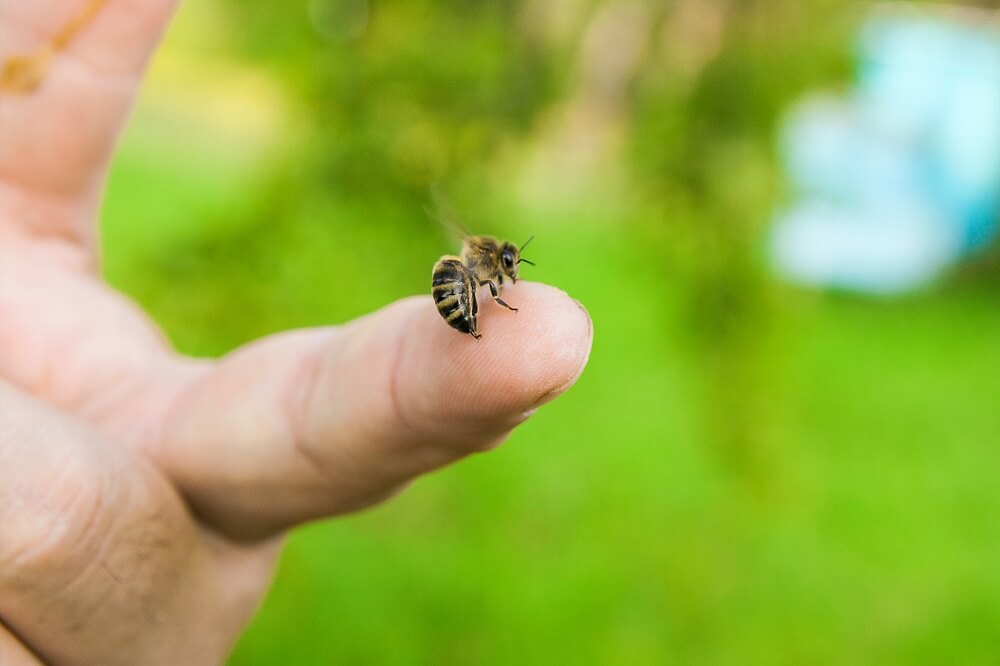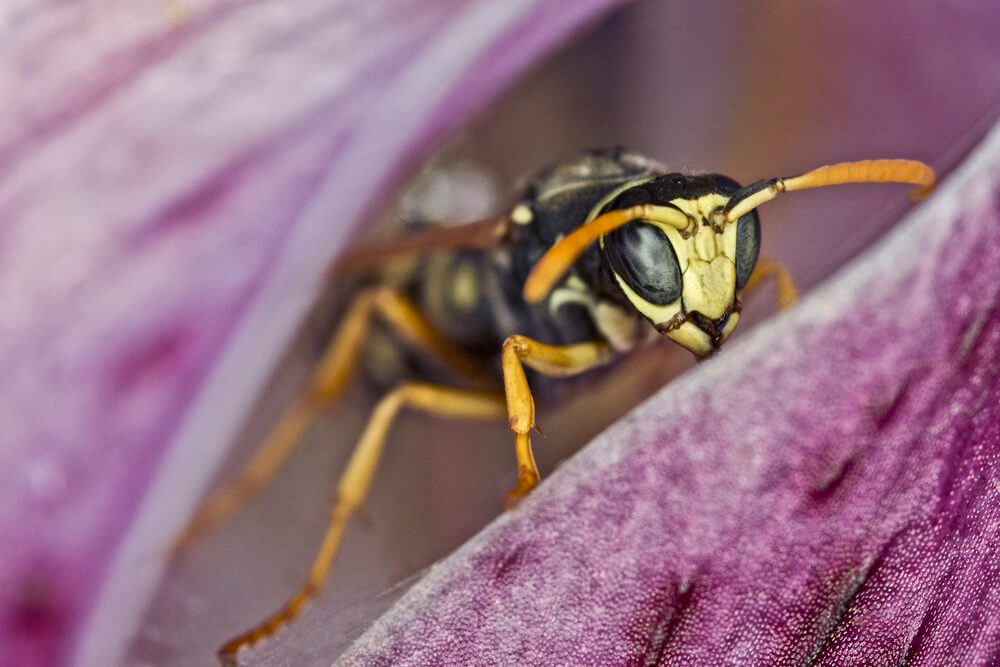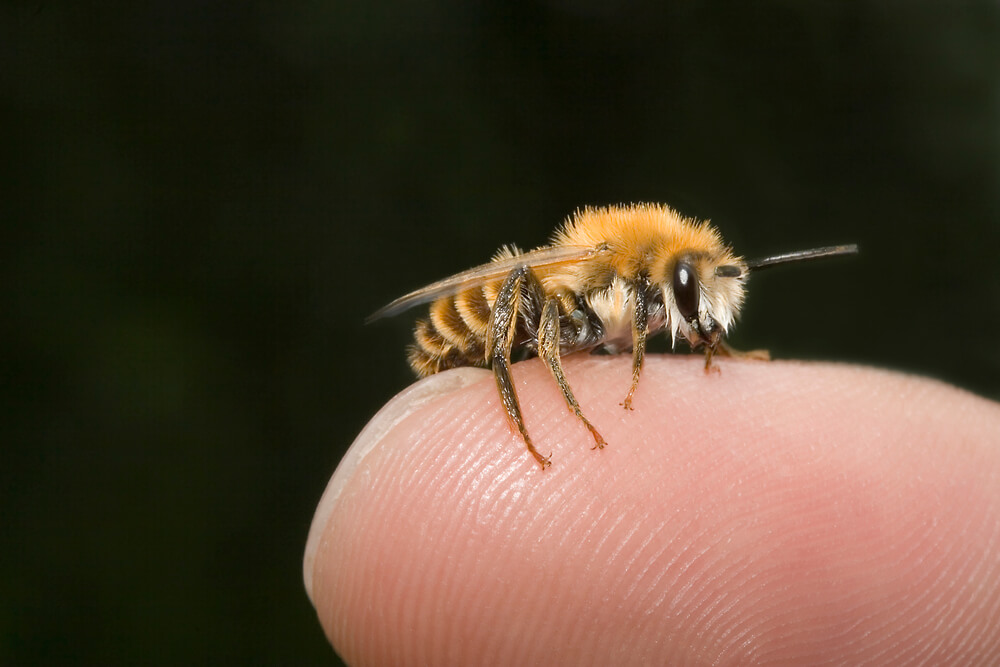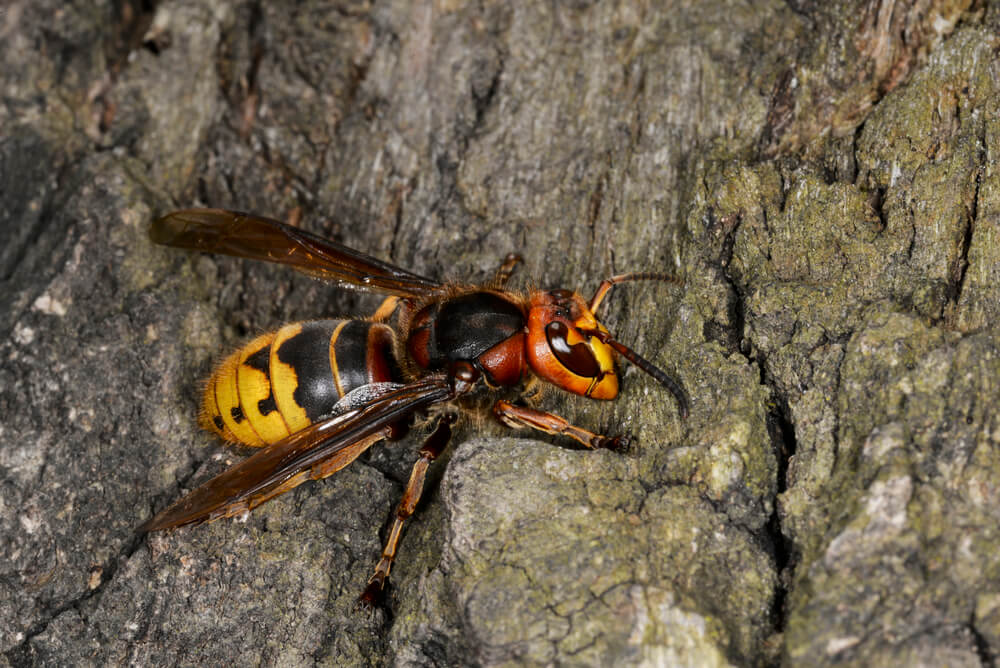Table of Contents:
What Does a Bee Sting Look Like and Feel Like?
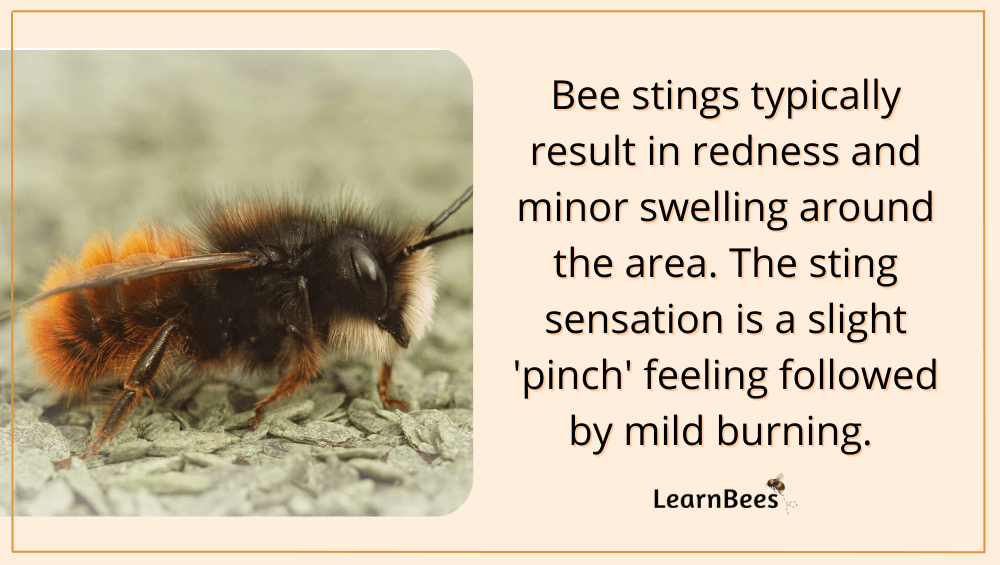
It’s the million-dollar question:
How do I know if I got stung by a bee?
For starters, a bee sting feels like a pinprick followed by a mild burning sensation. It’s more of a “pinch” feeling than a stinging feeling. Many people say the pinch sensation is like getting a shot from a doctor.
And to be honest with you?
A bee sting isn’t as painful as you might think. The slight burning sensation usually lasts less than 15 minutes. And for most people, redness and swelling will disappear within 24 hours.(1)
You can treat mild bee stings with this calamine lotion. Just keep a bottle handy during the warm months in case it happens again.
Now you might be wondering:
What does a bee sting look like?
It depends.
There are three reactions to bee stings:
- Mild
- Moderate
- Severe
Let’s discuss each.
1. Mild Bee Sting Reaction (Most Common)
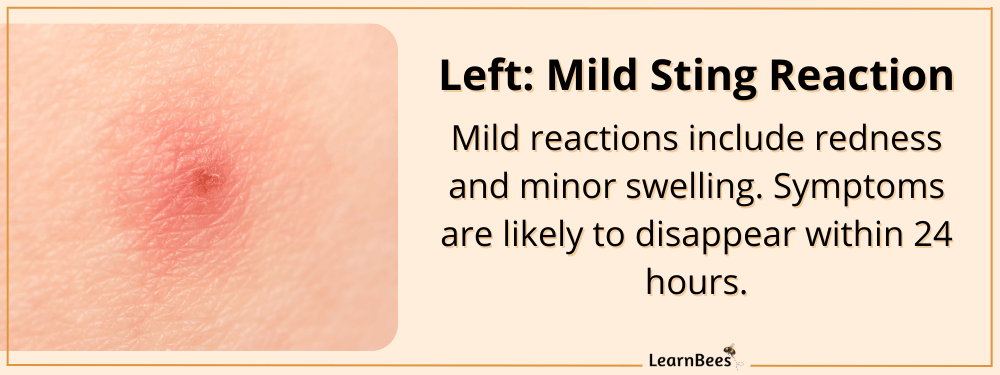
The most common bee sting symptoms are minor and can include:
- Instant, slight burning pain at the sting site
- Itching
- A small red welt at the sting area
- Minor swelling
2. Moderate Bee Sting Reaction (Less Common)
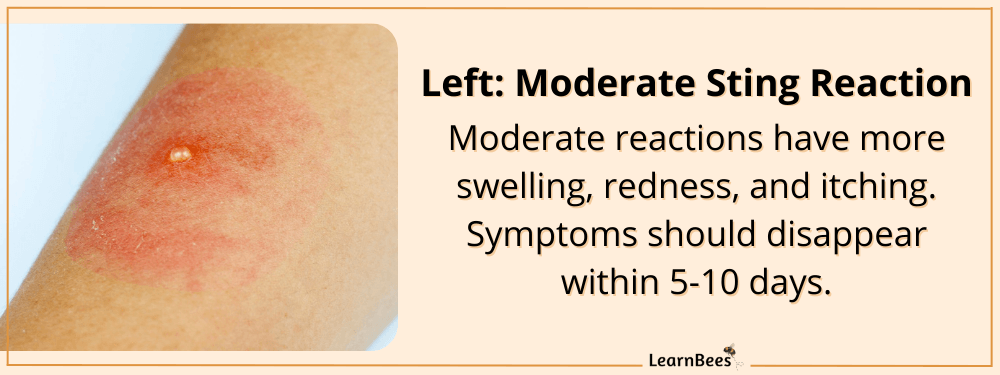
Some people who experience bee stings have stronger reactions, with symptoms such as:
- Extreme redness
- Itching at the sting site
- Swelling around the sting that gradually enlarges over the next day or two
3. Severe Bee Sting Reaction (Extremely Rare)
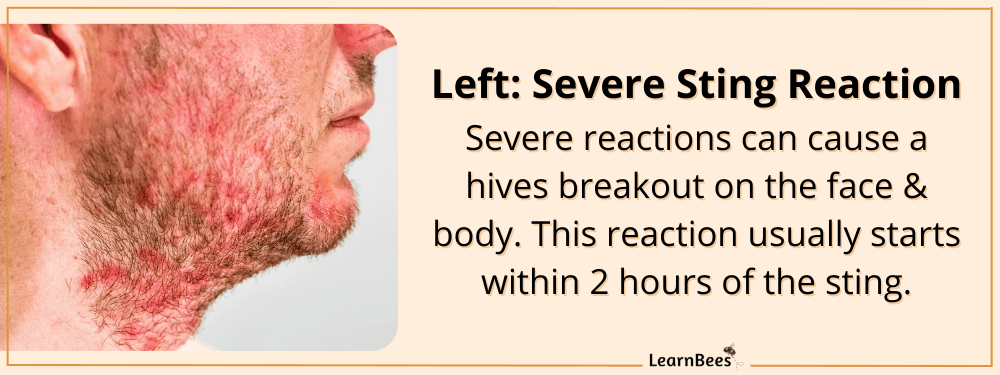
A severe allergic reaction (anaphylaxis) to bee stings only occurs in a small percentage of people.
Signs of anaphylaxis include:
- Hives, itching, and/or flushed skin
- Trouble breathing
- Swelling of the tongue or throat
- A weak, rapid pulse
- Vomiting, nausea, or diarrhea
- Dizziness or fainting
People with these reactions should seek emergency care.
How Long Does a Bee Sting Last?

As mentioned, most bee stings result in mild reactions. This includes slight redness, swelling, and itching at the sting site area. Mild reactions have symptoms that typically disappear within 24 hours.
To speed things up, you can apply this calamine lotion to ease any redness, itching, or swelling.
As for moderate reactions?
Moderate reactions include stronger symptoms such as swelling at the sting site that gradually enlarges over 2 to 3 days. You’ll also experience redness and itching, which can be reduced with calamine lotion.
Moderate reactions will resolve in 5-10 days.
And finally:
A tiny percentage of people have severe allergic reactions (anaphylaxis) to bee stings. This reaction occurs in about 3% of adults.(2)
Anaphylactic reactions to a bee sting typically begin within two hours of the sting and rapidly get worse. Hives can appear on the face and body, followed by other signs, such as headache, dizziness, nausea, and difficulty breathing and swallowing.
Severe reactions like these are potentially life-threatening. They require emergency treatment immediately.
What Happens if a Bee Stinger is Not Removed?
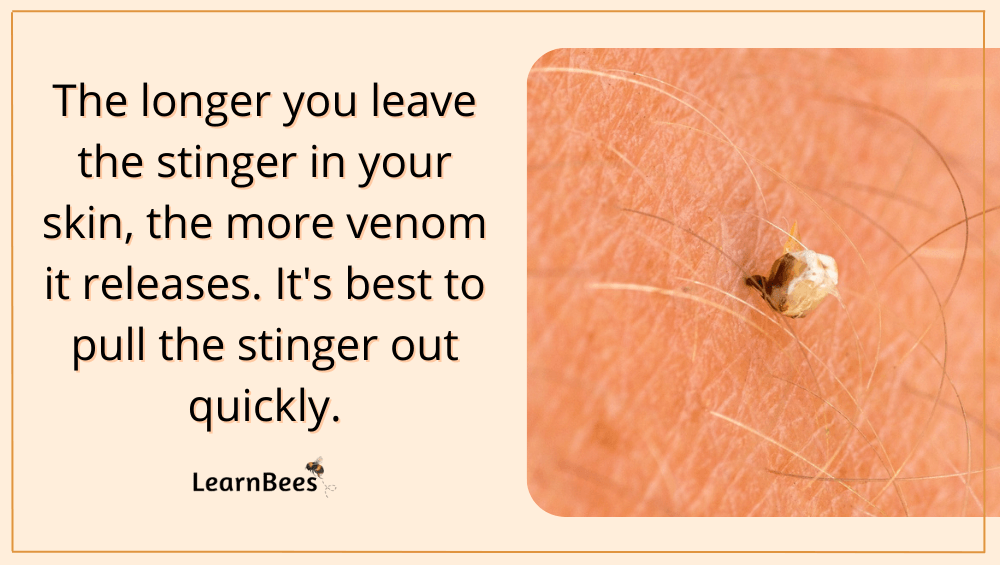
Keep in mind:
Most bees won’t leave stingers behind in your skin. In fact, it’s quite the opposite.
There are more than 20,000 different types of bees around the world. Common bee species include bumblebees, honeybees, and carpenter bees. And surprisingly enough, honeybees are the only known bee species that leave their stingers behind in the skin.
How come?
Because honeybees have barbed stingers with tiny ‘hooks’ on them. As a result, the stinger gets stuck in your skin once the honeybee inserts it.
But what happens if you don’t remove it?
In short, the longer you leave the stinger in your skin, the more venom it releases. Honeybees tend to release more venom compared to other stinging insects.(3)
Granted, the venom sac only has a limited amount of venom. So once it runs out, it’s done. That said, it’s best to remove the stinger quickly to reduce the chances of redness and itching.
How do you do it?
Softly scrape the stinger out with your fingernail or credit card. Then wash the area with soap and water to clean it. As mentioned, most bee sting reactions are mild and will disappear within 24 hours.(4)
You can apply calamine lotion to speed up the healing process.
FAQs about “What Does a Bee Sting Look Like?”
- How long does it take to have an allergic reaction to a bee sting?
- Why does a bee sting hurt days later?
- What does a bee sting look like if you’re allergic?
- What does a bee sting look like if the stinger is still in?
- What does a bee sting look like when you pull out the stinger?
- What does a bee sting look like the next day?
- What does a bee sting look like after 3 days?
- What does a bee sting feel like?
How long does it take to have an allergic reaction to a bee sting?
It varies from person to person.
Sometimes you may not experience an allergic reaction until 4 hours or longer after the sting. In contrast, some people may experience a reaction after just 5-10 minutes.
With that in mind, true allergic reactions are rare. Most people experience mild reactions that go away within 24 hours.
That said, allergic bee sting reactions can lead to more serious symptoms, such as swelling in the throat and tongue, trouble breathing, dizziness, and weakness. If you have any of these serious symptoms after a bee sting, you should seek medical attention.
Severe reactions could be a sign of anaphylaxis. It typically happens 5-30 minutes after the sting and can cause life-threatening symptoms such as airway swelling, heart irregularities, loss of consciousness, shock, or other symptoms.
—> Go back to the FAQs on “What Does a Bee Sting Look Like?”
More to Explore:
Why does a bee sting hurt days later?
Bee stings hurt because of the venom that’s injected into your skin. The venom contains various chemicals that cause pain, swelling, and irritation.
If your bee sting hurts for longer than three days, you may need to treat the area with calamine lotion. You can also take over-the-counter ibuprofen to help with the pain, swelling, and itching.
If the pain is severe and you develop hives or signs of an infection, you should see a doctor. If necessary, the doctor can treat the bee sting with steroid injections or antibiotics.
The good news is that moderate bee sting reactions should last no more than 5-10 days. Some other bee sting treatments may include:
- Soaking the area in vinegar
- Rubbing a baking soda paste on the sting (1:1 baking soda to water)
- Placing a cold compress on the area for 10-15 minutes
- Using essential oils to treat the sting (such as lavender oil or tea tree oil)
—> Go back to the FAQs on “What Does a Bee Sting Look Like?”
More to Explore:
What does a bee sting look like if you’re allergic?
If you’re allergic, bee stings can cause more serious reactions. Symptoms of serious reactions could include swelling of the lips, tongue, or throat, chest tightness, rapid heartbeat, hives, dizziness, or lightheadedness.
Severe allergic reactions (also called anaphylactic reactions) are uncommon. However, you should see a doctor immediately for treatment if you have a severe allergic reaction.
You might also seek medical treatment if you’ve been stung near the eye, ear, or mouth. Stinging in such areas can result in increased pain and swelling.
But you might be asking:
How common are bee sting allergies?
Around 2 million people are allergic to bee stings, according to the American Academy of Allergy, Asthma & Immunology. This equates to about 1% of children and 3% of adults.(5)
If you’re allergic to bee stings, you could also be allergic to wasps or hornet stings.
—> Go back to the FAQs on “What Does a Bee Sting Look Like?”
More to Explore:
What does a bee sting look like if the stinger is still in?
The stinger looks like a small, sharp barb attached to a venom sac. The stinger will be lodged into the skin, but you should be able to see the venom sac poking out. You’ll also notice a pink or red welt where the stinger pierced the skin.
You’ll want to remove the stinger quickly to avoid having it release more venom and cause more irritation. To pull it out, you can gently scrape the area with a credit card or your fingernail, then wash the area with soap and water.
If you’re allergic to bee stings, the venom may cause pain or swelling that lasts for hours or days.
—> Go back to the FAQs on “What Does a Bee Sting Look Like?”
More to Explore:
What does a bee sting look like when you pull out the stinger?
People often ask:
What does a bee sting look like in the skin? What do bee stings look like? What does a bee sting look like when you pull it out?
Bee stings look like small, red bumps on the skin. They may be swollen, irritated, and itchy. That said, the appearance of a bee sting isn’t as severe as you might think. The swelling and redness typically subside within a day or two.
When you pull out the stinger, you may notice a small, white dot where the stinger punctured the skin. This is normal and shouldn’t cause any long-term effects.
But remember:
Not all bees leave behind a stinger. Only honeybees have stingers that get stuck inside human skin. So, if you’re stung by another type of bee, you shouldn’t expect to see a stinger.
—> Go back to the FAQs on “What Does a Bee Sting Look Like?”
More to Explore:
- Honeybees vs. Bumblebees: How Do They Compare?
- How Many Eyes Does a Bee Have?
- How Long Do Bumble Bees Live?
What does a bee sting look like the next day?
The bee sting reaction should reduce by the next day. The swelling should go down, and the pain should be minimal. For some, the sting reaction may be gone entirely within 24 hours.
For other people, it can take a few days or longer to heal. You may still see a small, red bump where the sting occurred, but it shouldn’t hurt. Sometimes, the sting site might still be slightly itchy, but this is normal.
If you experience severe or prolonged symptoms after a bee sting, such as difficulty breathing or hives that don’t go away, you should see a doctor immediately. These symptoms could indicate a serious reaction.
—> Go back to the FAQs on “What Does a Bee Sting Look Like?”
More to Explore:
What does a bee sting look like after 3 days?
Bee sting redness and swelling can take 5-7 days for some people. This is a sign that your body is still working to heal the sting. The affected area may also be itchy as it heals.
If you notice any new signs after the initial redness and swelling goes down, such as increased pain or pus-filled blisters on the skin, you should see a doctor. These could be signs of infection.
Thankfully, most people don’t have severe reactions to bee stings, and their symptoms should clear up within a few days. You can speed up the healing process by applying calamine lotion or aloe vera to the affected area and taking over-the-counter ibuprofen.
Using ibuprofen for bee stings will help reduce pain. You can also apply a cold compress to the area for 15-20 minutes to reduce swelling.
—> Go back to the FAQs on “What Does a Bee Sting Look Like?”
More to Explore:
What does a bee sting feel like?
For most people, bee stings aren’t as painful as you might think. You’ll feel a pinch followed by a minor burning sensation. The pain is usually short-lived and goes away within a few minutes.
Some people describe a bee sting as feeling similar to a shot from a doctor. Others say it feels like being pricked with a needle.
It’s important to mention:
Getting stung in certain areas hurts more than others. For example, getting stung on your upper lip hurts more than getting stung on your arm.
—> Go back to the FAQs on “What Does a Bee Sting Look Like?”
